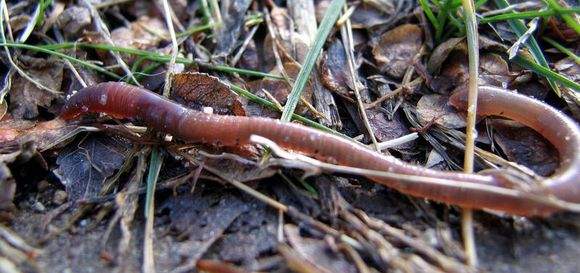An earthworm heads back into the soil (source: schizoform on Flickr)
I think we can all agree that sustainability in viticulture is important. I mentioned in my first post that our discussion about the science of biodynamics cannot leave out organic viticulture. I asked Alice Wise, viticulturist at the Long Island Horticultural Research and Extension Center (LIHREC) about some of the nuts and bolts of organic viticulture in Long Island.
NYCR: What are the primary challenges of organic viticulture in regions like Long Island?
AW: The goal is economically viable yields of high quality fruit – no matter what the management philosophy. Beyond that, growing season rainfall and morning dew favor fungal diseases such as black rot, phomopsis and downy mildew. The only National Organic Program (NOP)-allowed fungicide that provides significant control of downy mildew is copper, but no NOP-allowed material provides very good of control of black rot and phomopsis. Powdery mildew, on the other hand, is quite readily controlled by sulfur and mineral oil, both NOP-allowed.
NYCR: What are some ways to maintain nitrogen content in organic soil?
AW: Leguminous cover crops, though they must be tilled in for maximum benefit. There are organic nitrogen fertilizers such as peanut meal and others. They tend to be pretty expensive. For sandy soils, compost and/or composted manure helps with nutrition as well as nutrient retention. Realize that grapevines, at least vinifera on Long Island, do not need a lot of nitrogen so to me this is not one of the pivotal points of organic practice.
NYCR: How do organic treatments for downy, powdery, eutypa, botrytis, etc. differ from conventional treatments?
AW: The term organic is legally defined as it pertains to pesticide use. The NOP should have good information. Or go to http://www.epa.gov/pesticides/food/organics.htm.
The effective materials allowed for use by the NOP are all used by non-organic growers to one degree or another, particularly sulfur and mineral oil.
The exception might be copper. Some growers won’t use copper, or limit its use, because it has a 2,600 day soil half-life and permanently builds up in the soil to toxic levels with continuous use. This has not been an issue here but is an issue in more established winegrowing regions.
NYCR: Are conventional herbicides/pesticides really that bad for the soil?
AW: Anything that is done to soil potentially alters the structure and the biology – herbicides, cultivation, cover crops, they all have impacts. Regarding the impact of herbicides, I have read/heard discussions with arguments on both sides. One measure of potential impact (or lack thereof) of herbicides on the soil is their soil half-life*. A relatively low half-life means soil microorganisms consume the material and transform it to CO2 and H2O pretty quickly. Many modern herbicides have low leaching potential and short half-lives and are not considered “bad” for the soil. My opinion is that there is no perfect method to manage vegetation under the trellis, each option has advantages and disadvantages.
*Note: A word about half-life: Most processes are best assumed to occur in a first-order way. That is, things will undergo exponential decay. The term "half-life" is a function of the time constant of this decay. More simply, half-life is the amount of time it will take for half of the material of interest to degrade. After two half-lives, 25% (1/4) of the original material will remain. After 3, 12.5% (1/8), and so on. -tjm
NYCR: Copper is allowed in organic viticulture but – as you said – a common complaint is that it builds up in the soil. Are there any more eco-friendly copper alternatives at this time? Is copper buildup in soil as bad as some would claim?
AW: Copper use is limited and/or banned in some regions of Europe due to accumulation in the soil. Any soil copper level over 100 mg/kg is considered toxic and levels in French, Italian, Australian and New Zealand vineyard soils are not uncommonly found at 200, 300, 400+ mg/kg where copper has been used for decades. High soil levels of copper inhibit plant growth, impair soil microbial life, and drive out earthworms*. ‘Eco-friendly’ is not a legally defined term so I can’t comment on that. There are hydrocarbon-based, reduced risk options (for reduced risk definition, see http://www.epa.gov/pesticides/health/reducing.htm) for control of downy mildew but to my knowledge the only effective organic option is copper. Remember that both the active ingredient and inert ingredients must be approved by the NOP. Consequently, not all formulations of copper are organically approved. This holds true for other materials as well.
*Note: Earthworms are important to soils for many reasons, including their burrowing behavior, which increases soil drainage, and repeated turnover of the upper soil layer. Exposure to copper in earthworms at low levels can have detrimental effects on burrowing activity and at higher levels can be toxic to worms. Pictured right: Copper sulfate powder. -tjm
NYCR: You are running a trial on organic viticulture at LIHREC. Can you share any preliminary results?
AW: We are running the trial on chardonnay, probably the most difficult candidate for organic management. Overall, we have had difficulty with black rot, phomopsis and downy mildew in organic plots. Cluster rots have been problematic as well.
However, we have harvested fruit every year, though yields have been reduced. Vine size has suffered as well and we’re not quite sure why. Our current thinking is that it is due to cumulative stress rather than any one factor. We ended up using a conventional nitrogen fertilizer this year just because vine size was declining so much. It definitely helped.
NYCR: I assume leaf removal is essential for disease control in an organic regimen. What are your thoughts on the Long Island cultural practice of 100% leaf removal from the fruiting zone vis-à-vis disease control and fruit development?
AW: The issue of timing and severity of leaf removal is not specifically related to organic viticulture. Leaf removal in the cluster zone is done for both quality and pest management reasons for VSP trained vines. The more extreme version of leaf removal is done, as I am told by vineyard managers who do it, so that only one pass has to be made rather than repeated passes to maintain adequate air flow and light penetration. Some feel ‘leaf stripping’ of the cluster zone has quality benefits as well and I have seen some data to that effect. I have also seen fruit with sunburn – we did a version of leaf stripping this spring and ended up with a lot of sunburn on exposed clusters on the west side of the trellis. Whether the fruit is riper, we’ll find out at harvest.
NYCR: How does the cost of organic farming compare to conventional methods?
AW: As organic vinifera is not common in the eastern U.S., a standard set of practices has not really been recognized. So much depends on which pesticides and fertilizers are used as costs vary considerably. Often organic management involves an increase in labor. However, there is just not any solid information on costs. The version of organic that we used in our trial was more expensive than conventional methods but we only evaluated spray materials. I would guess there might be data from the west coast where there are many organic vineyards. But it would not be completely relevant to Long Island as the viticulture is so different.
NYCR: Have you tested any of the biodynamic preparations (e.g., horn manure, horn silica, compost treated with yarrow, valerian, dandelion, etc.) in your vineyard? Why or why not? Did you discover anything?
AW: No, nor will you find any true replicated studies with these preparations. In science, we have to reduce potential variability in treatments as much as possible. To my knowledge, there are no legal standards for producing these materials, hence variability in product might account for treatment differences. Some may even fall into a legal gray area as well since any product applied for control of a pest must have EPA and NYSDEC approval.
Regardless, since biodynamics involves a degree of faith or mysticism or whatever you want to call it, this does not lend itself to rigorous scientific evaluation. It may be interesting, but it would be hard to do a valid scientific study. And as biodynamics is a systematic approach, it might not make sense anyway to evaluate individual components. There was a west coast study that looked at conventional vs. organic vs. biodynamic over several years. It is summarized in the ASEV journal. I think it was done in WA and CA.
Note: One of the studies referred to can be found here and here. We'll be addressing the results of these studies in a later post.
So it seems like downy mildew is a real bugbear. For those growers who want to avoid using copper, there is an alternative known as phosphites. Phosphites have been shown to be effective against downy mildew, but the fungus can develop resistance to this chemical.
My understanding is that phosphite compounds are moving towards organic certification.
This brings up an interesting question. As was discussed in the comments section of part 1 of this series, sulfur, copper, hydrogen peroxide and mineral oil are "okay" to use in certified organic viticulture, but they are synthetic chemicals. Phosphite salts seem to be in the same vein.
What differentiates a fungicide like Captan from Phosphites? Both are made in synthetic chemical processes. Both have relatively short half-lives in soil. Is it their overall toxicity? Captan can be toxic to freshwater fish but Fosetyl-Al, a commercial phosphite preparation, can also be toxic to mussels. Both have been evaluated by the EPA and "can be used without causing unreasonable adverse effects in people or the environment."
If "organic" includes synthetic products, then where do we draw the line on synthetic? Or should we?
Further Reading:
For more information about herbicides and pesticides, visit ExToxNet
Organic Agriculture Trials at LIHREC
H Eijsackers, et al., "The implications of copper fungicide usage in vineyards for earthworm activity and resulting sustainable soil quality", Ecotoxicology and Environmental Safety, 2005.
JR Reeve et al., "Soil and Winegrape Quality in Biodynamically and Organically Managed Vineyards" AJEV, 2005.
H Thao and T Yamakawa, "Phosphite (phosphorous acid): Fungicide, fertilizer or bio-stimulator?", Soil Science & Plant Nutrition, 2009.
For more info on downy mildew, see this post from Evan from about a year ago.



